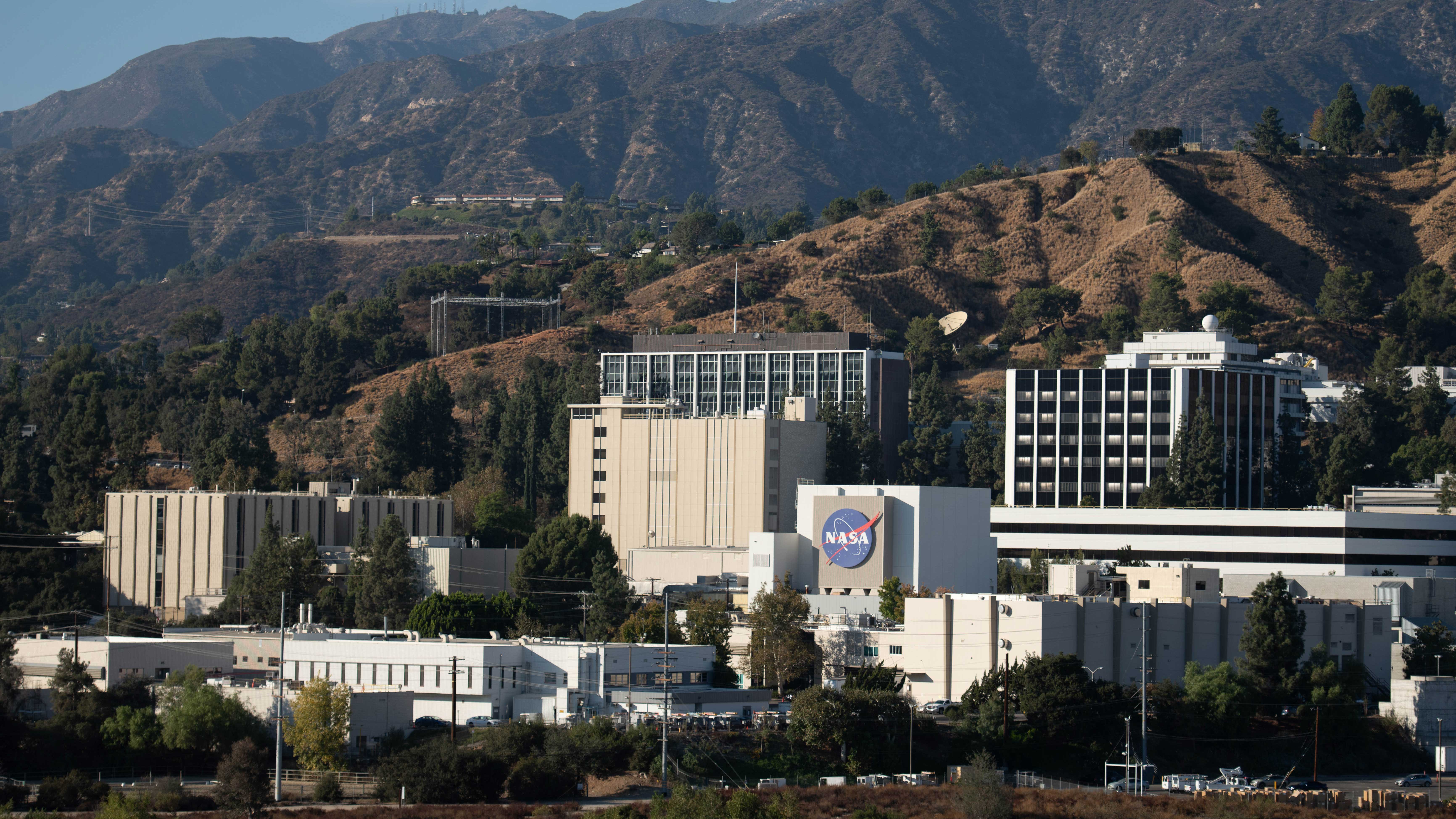
Budgetary issues have forced the Jet Propulsion Laboratory (JPL), NASA's chief center for robotic planetary exploration, to reduce its workforce by about 8%.
The cuts affect roughly 530 employees and 40 contractors, according to JPL officials, who announced the news this afternoon (Feb. 6).
"The impacts will occur across both technical and support areas of the Lab," JPL officials said in a statement today. "These are painful but necessary adjustments that will enable us to adhere to our budget allocation while continuing our important work for NASA and our nation."
Related: Facts and information about NASA's Jet Propulsion Laboratory
JPL, which lies just north of Los Angeles, is federally funded but managed by the California Institute of Technology. The center leads many of NASA's big-ticket science projects, such as the Curiosity and Perseverance rover missions on Mars.
One of Perseverance's main tasks is collecting and caching samples for future return to Earth. JPL is a driving force behind this ambitious Mars sample return (MSR) campaign, which aims to ratchet the search for Red Planet life up to new and exciting levels.
The projected budget for MSR has ballooned recently; last year, an independent review board estimated that the campaign will end up costing $8 billion to $11 billion if it gets off the ground by 2030 as planned.
Get the Space.com Newsletter
Breaking space news, the latest updates on rocket launches, skywatching events and more!
These numbers alarmed some members of Congress, who have sought to rein in MSR's costs. For example, the Senate allocated just $300 million for MSR in its fiscal year 2024 appropriations bill — a 63% decrease from the funding granted in 2023, as JPL Director Laurie Leshin noted in a letter to employees that the lab released with today's layoff announcement. (Fiscal years work differently than calendar years; fiscal year 2024 began on Oct. 1, 2023, for instance, and will end on Sept. 30, 2024.)
Congress has not yet come together to pass a final appropriations bill for fiscal year 2024 — the House and Senate are still negotiating — but NASA instructed JPL to plan for a $300 million MSR budget, Leshin said.
"In response to this direction, and in an effort to protect our workforce, we implemented a hiring freeze, reduced MSR contracts, and implemented cuts to burden budgets across the Lab," she wrote in the letter. "Earlier this month, we further reduced spending by releasing some of our valued on-site contractors."
However, as it turned out, these measures "are not enough for us to make it through the remainder of the fiscal year," she added. "So in the absence of an appropriation, and as much as we wish we didn’t need to take this action, we must now move forward to protect against even deeper cuts later were we to wait."
Related: The big reveal: What's ahead in returning samples from Mars?

NASA Administrator Bill Nelson lamented the JPL layoffs but stressed that they were necessary, given the budget situation.
"These painful decisions are hard, and we will feel this loss across the NASA family," Nelson said in an emailed statement.
"JPL has long been — and will continue to be — a shining example of America’s leadership in space," he added. "Even in the wake of current challenges, JPL will continue to help drive key upcoming NASA missions as we explore the cosmos with Europa Clipper, study our changing climate with the NASA-ISRO Synthetic Aperture Radar (NISAR), and defend the planet with the Near-Earth Object Surveyor space telescope (NEO Surveyor)."
Join our Space Forums to keep talking space on the latest missions, night sky and more! And if you have a news tip, correction or comment, let us know at: community@space.com.

Michael Wall is a Senior Space Writer with Space.com and joined the team in 2010. He primarily covers exoplanets, spaceflight and military space, but has been known to dabble in the space art beat. His book about the search for alien life, "Out There," was published on Nov. 13, 2018. Before becoming a science writer, Michael worked as a herpetologist and wildlife biologist. He has a Ph.D. in evolutionary biology from the University of Sydney, Australia, a bachelor's degree from the University of Arizona, and a graduate certificate in science writing from the University of California, Santa Cruz. To find out what his latest project is, you can follow Michael on Twitter.
-
George² I wonder when this lab last built and tested a brand new large rocket engine, as they say, from scratch?Reply -
Ranger11bv Reply
Then dont outsourse !Admin said:Budgetary issues have forced the Jet Propulsion Laboratory, NASA's chief center for robotic planetary exploration, to reduce its workforce by about 8%.
NASA's Jet Propulsion Lab laying off 8% of its workforce : Read more -
Joshua Zev Levin Reply
A lot of what goes into Hi-Tech Consumer Electronics come from technology derived from the Space Race. I propose a 3% Federal Excise (sales) Tax on Consumer Electronics to be dedicated to NASA. It will provide an ample and stable source of income for NASA, as well as give, to anyone buying a TV, smart phone, or computer, the satisfaction that a small portion of that purchase will go to putting humans on the moon, or sending robots to the outer planets.Admin said:Budgetary issues have forced the Jet Propulsion Laboratory, NASA's chief center for robotic planetary exploration, to reduce its workforce by about 8%.
NASA's Jet Propulsion Lab laying off 8% of its workforce : Read more
Of course, a lot of details would have to be worked out. Let the community know what you think by posting replies to this post. -
ChrisA Reply
That is not what JPL does, despite its name. JPL makes what goes inside the nose cone of the rocket. The engine is that thing at the other end of the rocket.George² said:I wonder when this lab last built and tested a brand new large rocket engine, as they say, from scratch?
As it turns out the thing at the top end has historically cost at least 10X what the engines cost. The lander that went to Mars is a 4 billion dollar device, the rocket that sent it there is about 200 million dollars.
JPL does the highest cost part of the mission. -
ChrisA Reply
This was the propaganda we were told in the 1960's. It really was not true then and is CERTAINLY not true today.Joshua Zev Levin said:A lot of what goes into Hi-Tech Consumer Electronics come from technology derived from the Space Race. -
billslugg The average profit of a business in the US is 7%.Reply
A 3% tax would put about half of them out of business.
https://www.thekickassentrepreneur.com/average-profit-margin-small-business/ -
George² Reply
The work of the Jet Propulsion Laboratory should be mainly that of the other end of the rocket, which ensures the delivery of the precious cargo, otherwise it would not be called that. As for how much the delivered freight costs. I think that the priority for profit is for private companies. Governments need to push technology forward, in this sense of the article, we need better engines. And since chemical ones are almost exhausted by development, they also have too little energy value. By now there should have been successfully introduced engines with a nuclear or thermonuclear energy source. If I don't count the problems in the 1960s, the many decades that have passed, progress should have led to technical challenges being overcome. I have the feeling that the state-owned companies of the USA do not seem to know that we are already in the 21st century, and their internal calendar has stopped at the beginning of the 1960s.ChrisA said:That is not what JPL does, despite its name. JPL makes what goes inside the nose cone of the rocket. The engine is that thing at the other end of the rocket.
As it turns out the thing at the top end has historically cost at least 10X what the engines cost. The lander that went to Mars is a 4 billion dollar device, the rocket that sent it there is about 200 million dollars.
JPL does the highest cost part of the mission.










